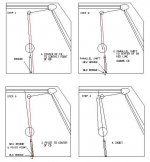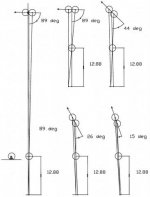RAAP... Reversed Angle Aim Point for the starting pivot point... Just sayin'...
.
.
Last edited:
RAAP... Reversed Angle Aim Point for the starting pivot point... Just sayin'
No swoops, sweeps, swipes, double vision lines, or Tom Cruise air pivots...
The pivoting V distances are unknown but are in direct proportions to each of the varying pocketing angles...
Maybe not direct proportions, but very close. There are a couple of ways to find where the pivot aim point starts from...
Approach the shot from behind the CB while looking at the angle the OB will take off the line between the CB and OB center...
.
I'm having a hard time visualizing this at the table Ralph.
Thanks
John
Hi 1PJohn... I'll get to the table in the next post. Please post input or questions if this RAAP thing doesn't make sense. Sometimes my wording is confusing.
Thanks.
.
Approach the shot from behind the CB while looking at the angle the OB will take off the line between the CB and OB center...
Went to the website shown in your signature. On the website #13 about 5 paragraphs down explains RAAP. I still don't understand. It is really hard to describe a system using words.
Is there a video available that demonstrates this system?
I like to learn all the pool related systems I can. I have my own system and I'm very comfortable with it. I am trying to learn CTE for banking because I play 1P and want to be able to bank from anywhere with confidence.
Thanks for the post.
John
The pivot always starts from the mirror angle of the OB contact point pocketing angle. The cue pivot point starts at a reversed aim point from the OB centerline.
Come straight down behind the CB. The cue should always be aligned with both balls. The cue alignment could run from center CB to center OB, or the cue alignment could run to the same point along horizontal lines on both the CB and the OB. It would be like a laser beam that's projected down the cue.
The laser beam projects through the CB to the same horizontal distance as it would project on the OB. This distance on the OB would be a point on the horizontal line that's opposite the OB contact point (or a reversed contact point). This Reverse Angle Aim Point (RAAP) is always inside the OB cut line.
If the cue is aimed centerball to centerball, or aimed at the same RAAP on the OB and the CB, the cue and both balls are aligned. Both balls need to be aligned with the cue to get equal distance pivots after finding the RAAP for the pivot. Center CB to Center OB is used on straight shots and small angled cuts.
On small angled cuts, the cue parallel shifts toward the opposite side of CB center. When the parallel shift aligns with the RAAP, pivot to the OB pocket aim point. On wide angles the cue points directly at the RAAP. Aim at both horizontal RAAP points and start the pivot from that point. Pivot toward CB center.
How far you pivot isn't a defined point. As the cue pivots, the shot line becomes clear.. although everyone sees things differently. Adjust if side spin is needed...
.
"The pivot always starts from a mirror angle of the OB contact point pocketing angle. The cue pivot point starts at that reversed distance from the OB center line."
I don't understand the bold part. I put an OB and QB on the table for a cut shot and stood there trying to figure out what a mirror angle looks like. Couldn't get it.
Maybe someone familiar with this will make a video to demonstrate.
Thanks for post #9 Carl.
I'll standby for now.
John
Are you saying align the cue parallel with the CB/OB centerline but pointed at the mirror image of the OB contact point (on the opposite side of OB center) - and then pivot to center CB to make the shot?
If that's what you're saying, then the correct pivot length is half the distance between the balls minus about 1".
pj
chgo
pj.. No. If cue is aligned parallel with the CB/OB centerline, and the contact point is 5/16" from OB center, the cue first shifts parallel 5/16" and aligns 5/16" parallel off the centerline of both the balls.
After balls are in line with the cue in the 5/16" shifted position, the pivot starts from the shifted position toward center CB. If it were a laser, the beam would get closer to the OB center faster than to the CB center. The beam then passes the OB center to a pocketing point on the opposite side of OB center.
The cue may not pivot to the exact CB center, but will be very close. I don't really care if it pivots to the exact CB center. As the cue pivots the shot line becomes very clear. The cue always aligns parallel from center CB/OB to the mirror image contact point before the pivot begins, unless the balls are very close, or it's a very thin cut.
Carl
.


It can be calculated for each shot - the pic below shows the geometry for that:There is really no set pivoting distance.
It can be calculated for each shot - the pic below shows the geometry for that:
The CB Contact Point must contact the OB Contact Point, so the CB Path must be parallel with the line connecting the two Contact Points.
The two shaded triangles are identical, and show that (in order for the cue stick to point through the CB's center of mass) the cue stick's pivot length must be equal to half the distance between the balls minus about half the CB's diameter (minus ~1").
If you use a different pivot length, then the CB's path must still be parallel with the line connecting the Contact Points, but the cue stick won't point through the CB's center (i.e., you'll be adding some side spin and squirt/swerve).
pj
chgo
P.S. I'm not trying to tell you how to use your own system, just giving you some background info.
View attachment 42848